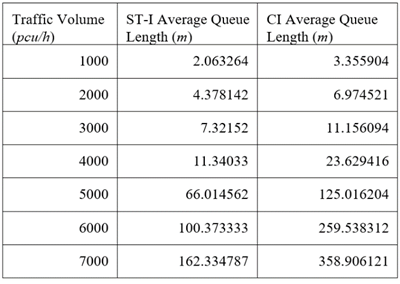-
Paper Information
- Paper Submission
-
Journal Information
- About This Journal
- Editorial Board
- Current Issue
- Archive
- Author Guidelines
- Contact Us
International Journal of Traffic and Transportation Engineering
p-ISSN: 2325-0062 e-ISSN: 2325-0070
2019; 8(1): 1-7
doi:10.5923/j.ijtte.20190801.01

Synergistic Traffic Intersection - A Method for Coordinating Vehicles and Facilitating the Introduction of Autonomous Vehicles
Kwok J. Leung
Bachelor’s Degree, Australia
Correspondence to: Kwok J. Leung, Bachelor’s Degree, Australia.
| Email: |  |
Copyright © 2019 The Author(s). Published by Scientific & Academic Publishing.
This work is licensed under the Creative Commons Attribution International License (CC BY).
http://creativecommons.org/licenses/by/4.0/

Developments in autonomous vehicles (AV) has many controversies regarding how the future will look like. Once AVs become popular, the tedious task of driving will become a past issue. Autonomous interaction between multiple vehicles will be possible, which will allow the grouping of vehicles into platoons. Recent advances in AV technology point to a future where vehicles can handle multiple driving tasks, increasing the driving efficiency and safety. Nonetheless, these advances in AV technology only refer to open-road driving, which is a well-studied and relatively easy problem to solve. Traffic congestion will no longer be caused by the human pilot, but rather the method by which vehicles are coordinated, especially where a plurality of roads intersects each other. Autonomous Intersection Management (AIM) is a proposed method which takes advantage of the increased precision and sensitivity of AVs by utilising the sensors on the vehicles to anticipate when each would reach the intersection and adjust their route and speed to proceed through without stopping, eliminating traffic signals altogether. We however anticipate that AV adoption will incur over a long transition period and it’s unrealistic to assume that all vehicles would possess fully autonomous capabilities at any stage of the future, as there is already an existing trend for collecting and modifying automobiles. This paper will provide an alternative solution to the inherited intersection management problem. The Synergistic Traffic Intersection protocol has been tested in simulation, providing the experimental results that will strongly attest to the efficacy of this approach. In addition, this report discusses the implications of this technology from an urban and transportation planning perspective.
Keywords: Traffic Congestion, Autonomous Intersection Management, Traffic Coordination, Autonomous Vehicles
Cite this paper: Kwok J. Leung, Synergistic Traffic Intersection - A Method for Coordinating Vehicles and Facilitating the Introduction of Autonomous Vehicles, International Journal of Traffic and Transportation Engineering, Vol. 8 No. 1, 2019, pp. 1-7. doi: 10.5923/j.ijtte.20190801.01.
Article Outline
1. Introduction
- RECENT developments in artificial intelligence and electric vehicles enabled the development of Autonomous Vehicles (AV), which has demonstrated a convincing level of safety and efficiency, enticing human drivers to give up piloting their vehicles. When projecting the future of this technology, Dresner and Stone proposed a new traffic intersection protocol called the Autonomous Intersection Management (AIM). It shows that by leveraging the networking and control capabilities of AVs it is possible to design a protocol that will enable vehicles to proceed through an intersection without the need to stop. Eliminating the need for traffic signals altogether [1]. This protocol is designed for when all vehicles are fully autonomous. However, the full transition to AVs is highly unlikely. Since the invention of automobiles, humans have not only used them as a tool to transport objects and passengers, but also as leisure and as collectible items. Even if government interventions can completely outlaw all automobiles without autonomous capabilities, when and how would this transition take place? And how would we educate road users?Furthermore, AIM suggests a protocol that will allow vehicles to approach an intersection without stopping, performing manoeuvres at near misses from other AVs. The simulation results of the AIM protocol are indeed enticing but fails to recognise a variety of factors involving the road users. It is therefore important to devise a system that will facilitate a smooth transition from human drivers toward AVs by considering the improvement of current infrastructure and introducing an organised and safe intersection management system. This article introduces a new protocol called the ‘Synergistic Traffic Intersection (ST-I)’, by devising an experiment that can evaluate the ST-I and the corresponding conventional intersection, and further evaluates the implication of this technology on the shared AV economy from an Urban & Transportation Planning perspective.
2. Preliminary
- The current traffic flow community frequently uses no-right turns (LHD) to improve traffic flow which eliminates the conflict points between the right-turning traffic and the opposing traffic. A Typical traffic intersection utilises a 4 phased system accommodating the 4 directions of traffic. The removal of right-turns enables a 2 phased system, allowing a higher frequency and longer ‘go’ signals. Contributing greatly towards the creation of a green wave and taking full advantage of a binary system. This is arguably ineffective, as alternative routing and additional manoeuvres are required, increasing travel time. The Continuous Flow Intersection also utilises a 2-phased system and relocates the right-turn, allowing through traffic to proceed whilst providing a protected right-turn movement [2]. However, this design was not intended to be used within an urban environment, due to the overall area requirement and the inconvenience caused to cyclists and pedestrians. The design is predominantly oriented for traffic flow without the consideration of buses and slow-moving vehicles, meaning that the composition of traffic flow in CFI is singular [3].The CFI involves the construction of additional pavement to form the right-turning bay, allowing the displaced right-turn. The additional pavement significantly widens the intersection, this promotes a division of the infrastructure on all sides of the intersection. And therefore, there’s a trade-off between the space available and the desired vehicular speed. Furthermore, CFI operates with high vehicle speed, elevating the anxiety of cyclists and pedestrians. With the above reasons, CFI couldn’t serve as a viable solution to the urban congestion problem. However, we can deduce an alternative whilst ensuring the consideration over CFI short falls.The Synergistic traffic intersection is an application of CFI technology that improves on the techniques by displacing the right turn within the original layout of the road, and introduces a wedged shape cleared zone to allow vehicles with multiple axles space to complete their turns [4]. The ST-I design involves minor changes to the civil architecture, road markings and the addition of traffic signals at the midblock intersection. This design will be cost effective and quick to construct as there’s no additional road construction needed. The ST-I requires equal or less space compared to the conventional concept and demands little changes to the current driving behaviours. The chapters below introduce the ST-I geometrically, discussing the traffic space design, traffic organisation design, and the traffic control design. Furthermore, in order to evaluate the design from a traffic flow perspective, an experiment was conducted to evaluate the performance of the ST-I and Conventional intersections (CI) using the microsimulation software VISSIM, allowing conclusions to be made over the suitability of the ST-I as a viable solution to the urban traffic congestion problem.
3. Synergistic Traffic Intersection
- A. Geometric Model of the ST-I.A mid-block intersection is placed in the road at a practical distance from the intersection shown in Fig.1. A mid-block intersection will be used as a shared space to relocate right-turning vehicles. Right-turning traffic gathers in the right-turn lane before the mid-block intersection (Lane 4), providing sufficient space to cross the opposing oncoming traffic towards the farthest right-side lane (Lane 6), prior to the main intersection in preparation of the right-turn. The right-turning vehicles pass through the main intersection into the receiving lane of the north-bound traffic. Left-turning vehicles proceed past the mid-block intersection using lane 1, remaining in lane 1 as they pass through the main intersection into a receiving lane of the south-bound traffic. The through traffic will proceed past the mid-block intersection using lane 2 and 3, as they proceed straight through the main intersection into a receiving lane and continue west-bound.
 | Figure 1. 6x6 Synergistic Traffic Intersection |
 | Figure 2. Traffic organization of right-turning vehicles |
 | Figure 3. Signal phases of ST-I |
4. Case Study
4.1. Test Intersection
- VISSIM was used to provide an evaluation of the CI under a four phased signal control, with specialised right turn lanes and channelized left turn lanes. The corresponding ST-I design in Fig.4 shows the visual output of VISSIM micro-simulator when evaluating the CI and ST-I.
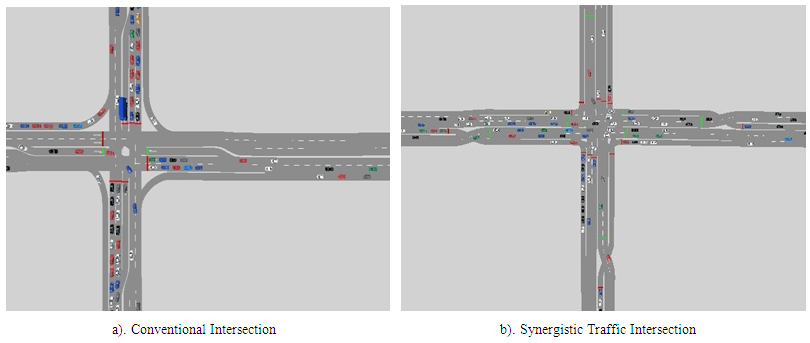 | Figure 4 |
4.2. Simulations
- In order to observe the proposed ST-I under different traffic volume conditions, this study designs several scenarios which are listed below. a) Assuming that each entrance lane has the same traffic demand and volume, the CI and ST-I traffic volumes were set to 1000 veh/h, 2000 veh/h, 3000 veh/h, 4000 veh/h, 5000 veh/h, 6000 veh/h and 7000 veh/h. Representing different traffic conditions from free to oversaturated. b) Each traffic volume will be simulated for 1h, totalling 7h for each intersection design. The turning ratios of right-straight-left set to 0.25-0.6-0.15 respectively. c) The total cycle time will be set to 120s. To overcome the stochastic nature of the simulation results, an average of 20 simulations was used.
5. Results
- Performance indies in this study are the average delay (Delay), and the average queue length of vehicles (Queue).
5.1. Traffic Efficiency Evaluation
- The simulation results evaluating the seven traffic conditions are shown in Table 1 & 2 and in Fig.5. & Fig.6. Throughout the simulation process the ST-I shows a stable increase in Delay and Queue when compared to the CI. The CI shows a major increase in the Delay between 4000 veh/h and 5000 veh/h, whereas the ST-I shows a relatively stable trend. The Queue length of CI also represents a greater increase in length after 4000 veh/h, whereas the ST-I show a smaller gradient increase.
|
|
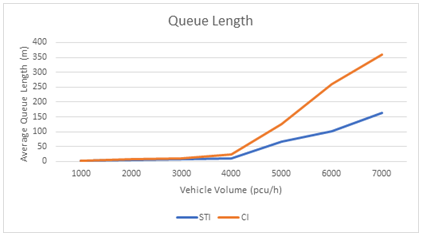 | Figure 5. Average Queue Length (m) vs Traffic Volume |
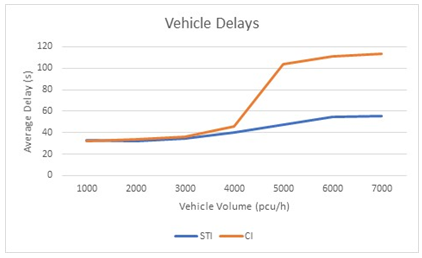 | Figure 6. Average Delay (s) vs Traffic Volume |
6. Discussions
- The above simulations show the ST-I under human driver characteristics and provides evidence to attest to the efficiency of the ST-I. Additional models will be needed to evaluate the varying composition of AVs and human drivers. It is expected that efficiency will heighten due to the enhanced precision and sensitivity of AVs. In this section we will discuss the implication of the ST-I with the emergence of AVs and discuss the implication of this protocol on current urban planning techniques, whilst highlighting the changes we expect toward public transportation.With the large-scale adoption of ST-I and AV technology, traffic congestion will be reduced. The Phantom Effect as described by Gazis & Herman [7], will decrease because of the ability for AVs to communicate and travel in clusters. AVs routing will be predetermined at the start of the journey, adjusting according to real-time traffic conditions. The introduction of ST-I will enhance the facilitation of AVs, increasing the convenience and allowing passengers to travel a further distance with less time.Furthermore, as AV technology becomes more prevalent, the concept of the shared vehicle will become more utilised due to its convenience and lower overall cost. As an effect, this 1) Reduces traffic congestion2) Public transportation such as buses will be greatly improved3) Less time spent on traffic jams, increasing the accuracy of public transport timetables 4) The demand for parking will also significantly reduce, permitting the removal of street parking on our urban roads, because empty autonomous vehicles can move to remote parking independently [8]. Allowing the roads to be better utilised by other road users (e.g. Cyclist, pedestrians and shared spaces).5) A computerised junction management system can be used throughout the network to ensure that AVs can be routed based on a time slot allocation [9]. Allowing AVs to proceed through intersections continuously as frequently as possible.This means that the design of our urban environments will dramatically change, reducing the overall demand for arterial roads while allowing non-arterial roads to be more pedestrian and cyclist friendly.
7. Synergistic Reconfigurable Traffic Intersection
- Once AVs become the predominantly used vehicles, we can then introduce additional road rules to change the way vehicles are coordinated to capitalise on the precision and sensitivity of AVs. The ST-I can be easily converted to a Synergistic Reconfigurable Traffic Intersection (SRT-I), refer to Fig.7, which involves the relocation of the sheltered right-turn at the mid-block toward the kerb-side lane. This will allow the middle lanes to service straight travelling vehicles only. These lanes can then utilise Reversible Lanes, which traffic may travel in either direction, depending on displayed overhead signal according to real-time traffic demand.
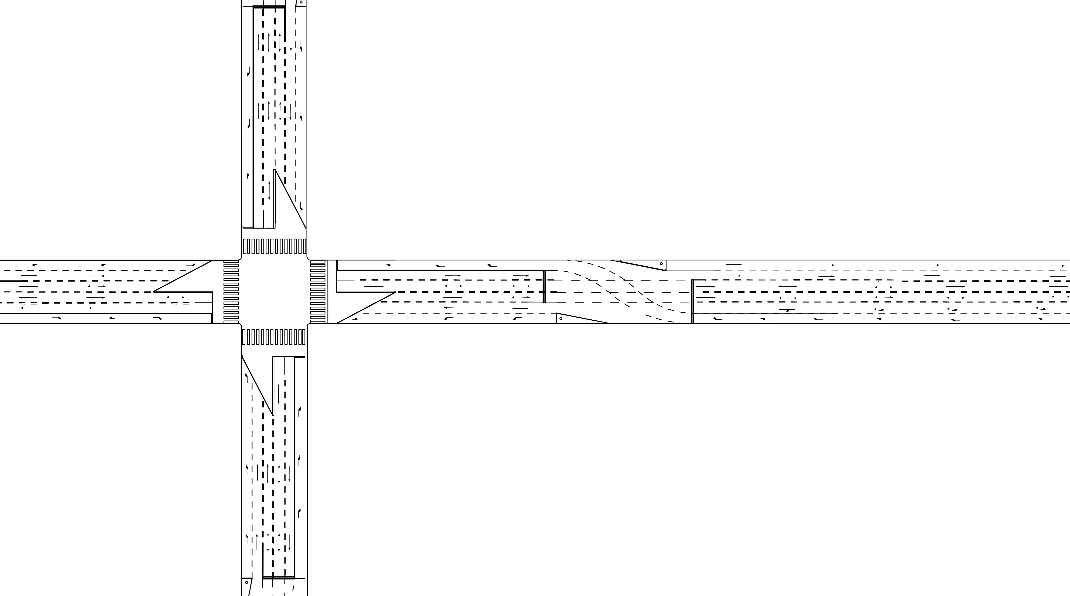 | Figure 7. Synergistic Reconfigurable Traffic Intersection |
8. Conclusions
- This paper provides an alternative to the proposed method known as Autonomous Intersection management by considering the limiting factors of that would discourage such a system to be introduced in the real-world. And to develop a process to enable the introduction of vehicles with autonomous capabilities and a coordinated protocol that empower the shift from human drivers to AVs.We introduce the Synergistic Traffic Intersection and provided design experiments as evidence to attest to the efficiency of the system. This paper argues that this system is an alternative to conventional intersection management and coordination whilst shed light on the effects of the ST-I on the current traffic condition, whilst providing a process to assist the adoption of AVs.
Appendices
- Swept Path AnalysisSwept Path Analysis of the Synergistic Traffic Intersection using AutoTurn, an industry-leading vehicle swept path analysis and turn simulation software. Please refer to Fig. 8.According to Australian Designed Vehicles - Austroads 2013 19m Prime Mover & Semi-trailer Width 2.5m x Length 19m & W/W Rad 13.245m.
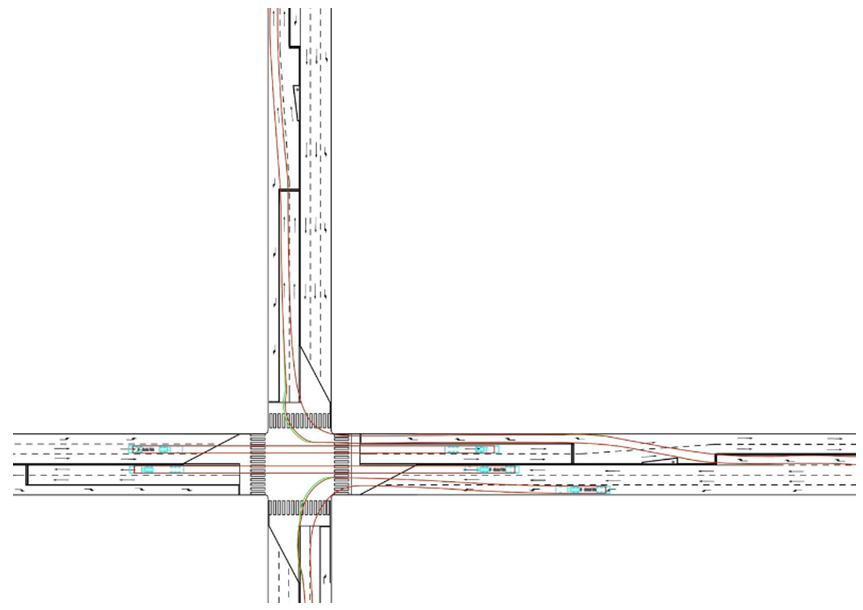 | Figure 8. Swept Path Analysis |
 Abstract
Abstract Reference
Reference Full-Text PDF
Full-Text PDF Full-text HTML
Full-text HTML